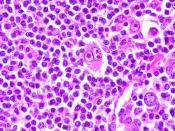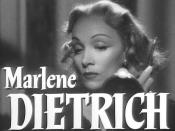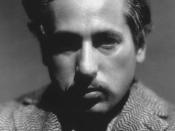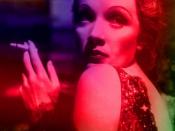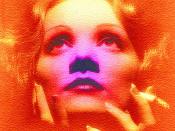Maria Magdalene Dietrich was born in the Berlin suburbs of Schoneberg on December 27, 1901 to an officer of the Royal Prussian Police, Louis Erich Otto Dietrich, and Wilhelmina Elizabeth Josephine Felsing, who was from a well-known family of Berlin jewelers. Although, her family was not rich, they did live a very comfortable life; where Dietrich was taught to play the piano and the violin. It was with the ever persistent war of World War I that changed her life around, causing her to lose her father and later a step-father, Edouard von Losch, to the war. After losing two men in the military, Dietrich?s mother became very strict and withdrawn, refusing the affection from her two daughters. She instilled in them the importance of independence, cooking, cleaning, behaving like a lady, and never to show one?s real feelings. Dietrich?s mother went out of her way to make sure her children had the best instructors.
Dietrich had believed for a long time that she would become a concert violinist, until she suffered severe muscle damage in her hand and was advised to no longer play any difficult instruments: ?This made a career as a concert violinist unthinkable and unbearable for me. I gave up completely?I read and read, and there was no end to the books I wanted to read. One day I came upon a section in a book by a German poet, which I found unspeakably beautiful?Around the time I began to think seriously about a theatrical career [?]? In 1921, Dietrich auditioned for Max Reinhardt?s famous acting school in Berlin against her mother?s wishes. She was not accepted, but she auditioned again six months later and was admitted under the name, Marlene Dietrich, which she formed after joining the first and last syllables of her two names. As a struggling actress, Dietrich found and married casting director, Rudolf Sieber. In 1925, they had a daughter together named Maria. Dietrich put as much time into her family as she could, and enjoyed being a mother more so than acting, which started to become boring to her.
Dietrich?s earlier film career consisted of her being an extra, dancer, or an easily forgettable character with one line. The first film which she appeared in with actor Emil Jannings, was a silent called, Tragedy of Love, but she brought a lot to that character through her eyes, ?a young woman so at ease with her appeal that she very, nearly takes it for granted? (Spoto 9). It was not until director, Josef von Sternberg, came across Dietrich in a musical, Two Neckties, that he became captivated and realized he had his Lola. No one else seemed to agree with Sternberg and insisted that he cast someone else in the role of Lola. Sternberg had his vision and no one was going to disrupt it; he made it clear that Dietrich would play Lola or he would walk from the project.
Sternberg?s vision became a reality with Dietrich in tote. She was easy to work with, guide, and she listened. There weren?t many times that he had to instruct her to do a scene over again, and others resented her. Although, Emil Jannings, who played Professor Rath (which means garbage and/or excrement in German) in The Blue Angel, was paid a nice sum of $200,000 and Dietrich, $5,000, he was still envious of the attention she received from the director. Jannings realized that Dietrich was being groomed to become an international star and almost succeeded in killing her during the strangulation scene in the film (Spoto, 24).
Dietrich did, in fact, become an international star and was well accepted into Hollywood along with Josef von Sternberg. For Dietrich to be marketed correctly she had to lose thirty pounds, extract a few teeth, push back her hairline, and file a few front teeth, which she had no problems adhering, too. Audience viewers were shocked to see her strong resemblance to that of MGM?s actress, Greta Garbo, but that was Paramount?s intentions (Spoto,44). Paramount went to great lengths to conceal the fact that Dietrich was married and had a child to further add to her mystique.
Although, at one time Dietrich was bored with acting, she no longer was when she became a Hollywood star and it became evident with her many starring roles. It was not only the money that kept her in the entertainment business; it became her passion. Her nicely, shaped legs may have been her beginning trademark, but it was not only her physique but her persona that captivating me when viewing Blue Angel. An attractive lady, indeed, but it sometimes takes more that just looks for an entertainer to maintain and survive in a cut throat business. Dietrich had a star quality that Sternberg saw and others were able to bear witness, too. Her voice was nice and she was a decent actress with wonderful stage presence, and that?s how she stole the show.
WORKS CITED Morley, Sheridan. Marlene Dietrich, New York: McGraw-Hill Book Company, 1977.
Spoto, Donald. Falling In Love Again Marlene Dietrich, Toronto: Little Brown Company, 1985.
Spoto, Donald. Blue Angel: The Life of Marlene Dietrich, New York: Doubleday, 1992.

